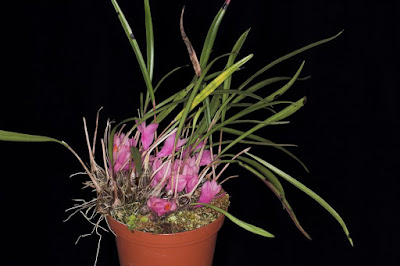Dendrobium brassii is native to Papua New Guinea. These plants are found in the Port Moresby District of the Central Province, in the Northern Province and in the Milne Bay Province. They grow epiphytically in forests composed of Nothofagus and Castanopsis trees, on exposed stands, at an altitude of 1500-2200 m.
Dendrobium brassii, also called as Brass's Dendrobium, is a species of the genus Dendrobium. This species was described by T.M.Reeve & P.Woods in 1989.
IDENTIFY DENDROBIUM BRASSII
Dendrobium brassii is native to Papua New Guinea. These plants are found in the Port Moresby District of the Central Province, in the Northern Province and in the Milne Bay Province. They grow epiphytically in forests composed of Nothofagus and Castanopsis trees, on exposed stands, at an altitude of 1500-2200 m.
It is a medium sized, cool to cold growing epiphyte, which reaching 8-22 cm in height, with generally clustered, erect to pendant, nearly ovoid, contracted in the middle, 0.5-2.5 cm long stems carrying a single, acute, 5-16 cm long, green suffused with purple leaf.
Brass's Dendrobium blooms in the winter and spring on a short, 2 flowered inflorescence arising at the apex of older leafless pseudobulbs and carrying long-lasting flowers. The flowers are 2.2-3.2 cm long. The petals of both whorls are purple-pink to violet and the orange top of the lip. The dorsal petal is oval-elliptical, the lateral outer petals are triangular, the petals are the internal longitudinal-oval, and the lip is slightly 3-spline.
DENDROBIUM BRASSII CARE AND CULTURE
Cultural information should only be used as a guide, and should be to be adapted to suit you. Your physical location; where you grow your plants, how much time you have to devote to their care, and many other factors, will need to be taken into account. Only then can you decide on the cultural methods that best suit you and your plants.
Light:
Dendrobium brassii needs a light level of 25000-30000 lux. These orchids require moderately strong light and strong air movement. In the summer, 50% shading should be provided. The level of light should be as high as possible, which only the plant can bear without burning the leaves.
Temperature:
The average temperature of the day throughout the year is 18-22 ° C, night 13-14 ° C, giving a daily difference of 5-8 ° C.
Humidity:
Brass's Dendrobium needs the humidity of 70-75% for most of the year, and in winter the humidity can increases to 80%.
Substrate, growing media and repotting:
Dendrobium brassii can be mounted on tree rootstocks or cork, provided that high humidity is ensured and watering is carried out at least once a day in summer. When growing in pots, any loose, quickly drying ground is recommended. Repotting can be performed when new roots grow.
Watering:
The frequency and abundance of watering the orchids of this species directly depends on the overall temperature of the content and intensity of the illumination, the higher they are, the more often and abundant it is necessary to water. In five summer months, precipitation is moderate, and in winter it is more dry. The plants must dry slightly between waterings.
Fertilizer:
It is recommended to apply a 1/4-1/2 dose of orchid fertilizer weekly. From spring to mid-summer, high-nitrogen fertilizer should be used, and then until the end of autumn with high-phosphoric fertilizer.
Rest period:
In 6-7 winter months, Dendrobium brassii need less water, especially those grown in dark, short days at moderate latitudes. Plants should be moist and should never completely dry out. Occasional light misting will be beneficial, as an addition to normal watering during bright, sunny mornings. When reducing the amount of water, fertilization should be reduced.















COMMENTS